Blink-182. For many, that name instantly conjures up images of skate parks, catchy hooks, and the unmistakable guitar riffs of Tom DeLonge. As someone who grew up during the peak pop-punk era, the original Tom DeLonge signature Fender Stratocaster was always on my radar. So, the announcement of a reissue, coinciding with Blink-182’s reunion, was met with considerable excitement. Fender bringing back this stripped-down, punk rock machine felt like a perfect storm of nostalgia and renewed interest.
However, the journey from announcement to guitars in players’ hands hasn’t been entirely smooth. Alongside the hype, whispers of concern regarding the retail price and quality control (QC) began to surface. A customer recently brought in their Daphne Blue reissue, giving me the opportunity to inspect and set it up, and to really see what this guitar is all about.
Price Point and Initial Reactions to the Tom DeLonge Guitar Reissue
Original Tom DeLonge Stratocasters, depending on their condition, have consistently sold for between £1500-2000 in recent years. This reflects strong demand for a model that originally retailed for around £400-500 in the early 2000s. Discontinued and popular models naturally appreciate in the used market due to supply and demand. Considering inflation, the current used prices are arguably justifiable for a collector’s item that also serves as a functional guitar, tapping into early 2000s rock nostalgia. Factoring in inflation, that original £400-500 price tag would be roughly £750-900 in today’s money (2023).
The reissue, however, enters the market at £1300. This price point has undeniably caused debate within the guitar community, especially for a Mexican-made, minimalist Stratocaster. “Affordable” is subjective, but the price has understandably sparked discussion even before the guitar became widely available.
Quality Control Issues: A Shadow Over the Reissue
Beyond the price, Quality Control has become a significant talking point. Reports of QC issues from early buyers have circulated widely online. While original models weren’t immune to occasional flaws – as evidenced by a recent guitar page showcasing an original with a multi-piece body – the volume of QC concerns surrounding the reissue is concerning. These reports cast a shadow over the otherwise exciting re-release. Neck and bridge alignment problems are among the most frequently cited issues. It’s a real disappointment for fans who have eagerly awaited this guitar. Whether due to rushed production or a general decline in QC standards, the situation is unfortunate.
Changes and Nuances in the Reissue
Examining the Daphne Blue reissue closely, I noticed some subtle but noteworthy changes compared to the original early 2000s models. Overall, these changes are positive improvements.
The factory setup, as is often the case with production guitars, required adjustment. This is standard across brands; most new guitars benefit from setup tweaks. However, post-setup, this particular Tom Delonge Guitar reissue resonated exceptionally well, a trait I hope is consistent across the production line. Hardtail Strats are known for their resonance, and this one certainly lives up to that reputation.
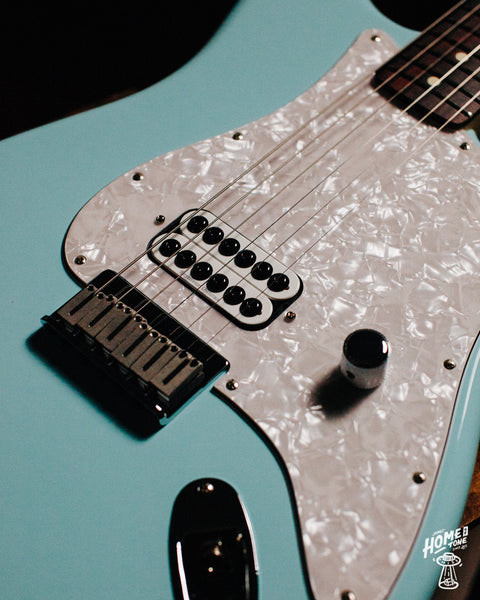
This specific guitar featured a beautifully dark rosewood fretboard, exhibiting the desirable deep, reddish-brown hue of quality Indian Rosewood. The fretwork was generally well done, with only minor high spots – a common occurrence even on new guitars from various factories. Nut string spacing was accurate, and the tuners functioned smoothly. In recent years, Fender’s nut string spacing QC has been inconsistent, so it was reassuring to see this example done correctly.
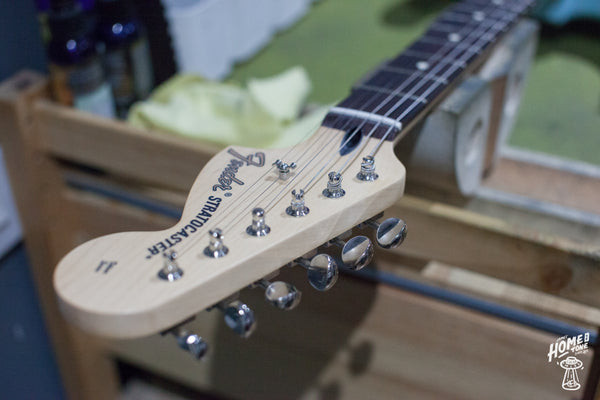
One minor QC oversight was a string tree hole not drilled to sufficient depth. This prevented the string tree from being fully tightened, leaving a gap between the “winged” piece and the spacer. Correcting this required a simple adjustment to ensure proper string tree installation.
The neck pocket exhibited a tight and precise fit, a feature reportedly lacking in some other reissues. Bridge alignment was slightly off, but not significantly enough to hinder setup. However, some reported bridge alignment issues on other guitars have been severe, warranting returns. While this example was acceptable, such issues shouldn’t occur on new instruments from a major brand. Correcting severe misalignment would necessitate filling and redrilling bridge mounting holes – an unacceptable fix for a brand-new guitar.
A notable, and welcome, change is the satin finish neck. This provides a smooth, fast feel, ideal for energetic playing. While the satin headstock might not align with everyone’s visual preference, particularly those seeking exact replicas of the gloss-finished originals, the playability benefit is undeniable.

The updated bridge is another improvement. Featuring modern block saddles, similar to those found on Tom DeLonge’s custom shop Strats, this is a step up from the original production run’s bridge. The body routing is typical of modern Mexican Fenders, utilizing an HSH pickup cavity route. While not specific to a single pickup like some Squier Tom Delonge models (interestingly), the original Fender signature models also used a similar universal routing.
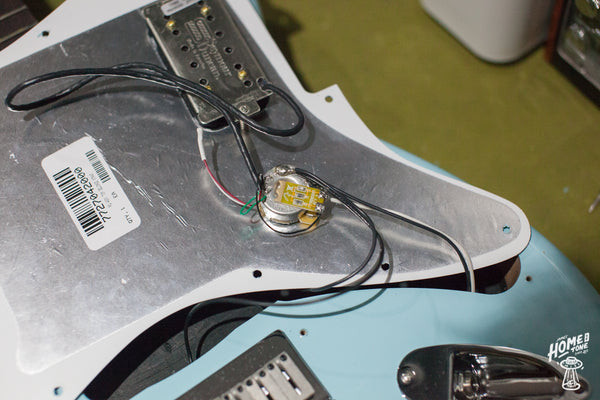
I was curious about the treble bleed circuit and discovered Fender opted for their 7711095001 PCB treble bleed, common in many newer production models. This differs from the original spec, which used a 680pF ceramic capacitor with a 220kOhm resistor. The new PCB version uses a 1.1nF capacitor, a 150kOhm parallel resistor, and an additional 47kOhm series resistor. The rationale for this change isn’t clear, especially since Tom DeLonge’s personal guitars lacked treble bleeds. It’s likely a production efficiency decision, utilizing a standard component across various MIM models. Regardless, the new treble bleed works effectively with the volume taper and the Seymour Duncan Invader pickup.
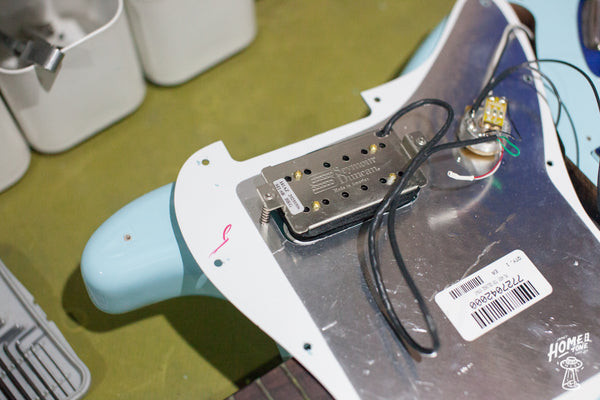

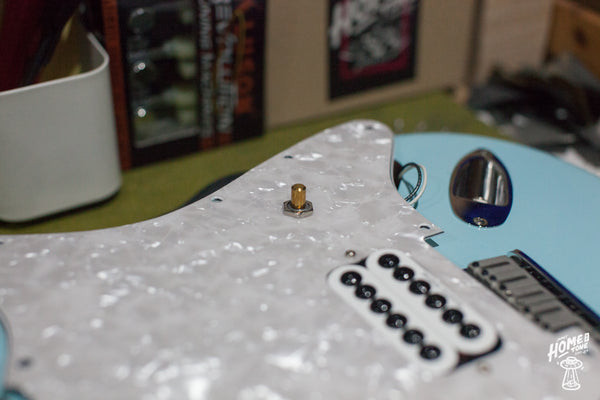
Wiring and component installation on this guitar were clean and professional. However, the neck pocket angle necessitated an unusually low pickup height for the Seymour Duncan Invader. To achieve a comfortable string-to-pickup distance, the pickup needed to be almost flush with, or even slightly below, the pickguard. Given the Invader’s high output, this isn’t detrimental to the sound, but it does mean the pickup height adjustment screws are near their limit.
Final Verdict: A Good Tom DeLonge Guitar, If You Choose Carefully
In summary, this particular Tom DeLonge guitar reissue was a good example, especially considering the widespread reports of QC issues. Many buyers have received guitars with unacceptable flaws for a £1300 instrument. It’s truly unfortunate that these guitars left the factory and dealer networks with such issues unnoticed or unaddressed. Thankfully, this specific guitar, after setup, played and felt great. Minor issues aside, they weren’t significant enough to detract from the overall experience.
The Tom DeLonge signature Stratocaster is an iconic model for a generation of players. Over my eight years in the guitar industry, countless customers have expressed their fondness for these guitars. Fender’s decision to reissue them is welcome, but the apparent rush to production has resulted in inconsistent QC. The price point is debatable, but considering inflation and the value of original models, it’s somewhat justifiable. The original run sold out, indicating that the price wasn’t a barrier for many.
Ultimately, I enjoyed reviewing this reissue and noting its nuances compared to the originals. While this was a positive experience due to this being a well-made example, my assessment would be considerably different had it exhibited major alignment problems seen in other guitars. My strongest recommendation for anyone considering buying a Tom DeLonge guitar reissue is to purchase in person. Thoroughly inspect the guitar – check the neck pocket, nut spacing, bridge alignment, and overall finish – before buying. Supporting local guitar shops and carefully examining the instrument is crucial. If a guitar isn’t up to standard, be prepared to walk away and wait for a better example. Patience will be rewarded with a well-made Tom DeLonge Stratocaster.
Hopefully, this detailed look provides valuable insights into the specifications and quality of the Tom DeLonge guitar reissue.
- James

